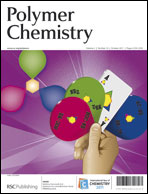A conjugated polyelectrolyte brush (PB3) composed of a polyfluorene backbone and poly[2-(dimethylamino)ethyl methacrylate] (PDMAEMA) side chains is synthesized via atom transfer radical polymerization (ATRP), and its properties are investigated and compared with its linear counterpart (P2, poly[9,9′-bis(6-N,N,N-trimethylammoniumhexyl)fluorene] dibromide). Despite the same conjugated backbones for PB3 and P2, the polymer brush architecture of PB3 endows it with an extremely high charge density, consequently give rise to better optical stability, higher water solubility (28 mg mL−1) and higher quantum efficiency (52%) as compared to those of P2; moreover, it induces stronger electrostatic attraction with oppositely-charged analytes, making PB3 contact the energy donor or quencher molecules much more efficiently than P2 does. As such, PB3 can afford not only higher FRET-amplified dye emission but also larger fluorescence quenching constant as compared to P2. With its high water-solubility, the fluorescence of PB3 sustains in the presence of a large amount of ssDNA, showing its optical durability in complicated biological media. As a result, CPE brushes could constitute a new generation of water-soluble fluorescent macromolecules having desirable optical and biochemical properties for various sensing applications.

You have access to this article
 Please wait while we load your content...
Something went wrong. Try again?
Please wait while we load your content...
Something went wrong. Try again?


 Please wait while we load your content...
Please wait while we load your content...